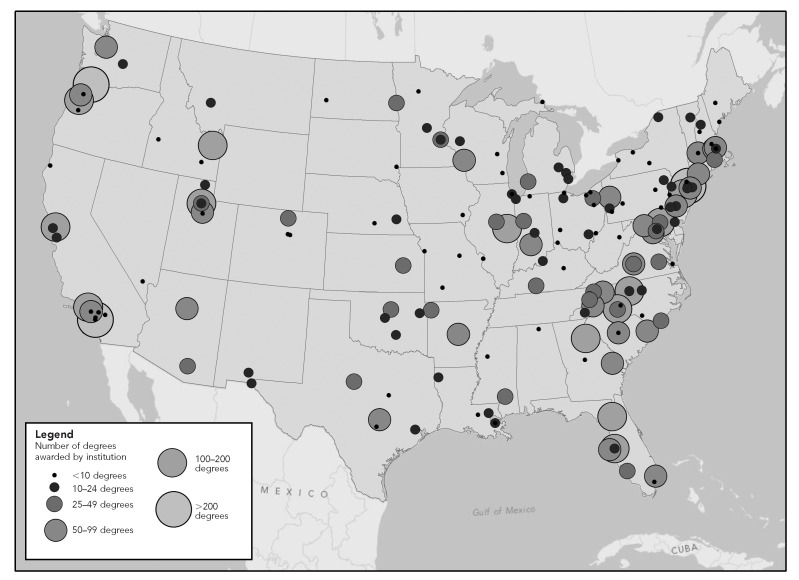In 2003, the Institute of Medicine called for all undergraduate college students to have access to education in public health.1 Several major national initiatives have been launched to achieve this goal, such as the Educated Citizen and Public Health Initiative hosted by the Association of American Colleges and Universities in partnership with the Association of Schools and Programs of Public Health (ASPPH), and the ASPPH-led 2010 Undergraduate Public Health Learning Outcomes Model that introduces students to public health at two- and four-year colleges and universities.2,3 Recognizing the need for information specifically for undergraduate degrees in public health, ASPPH then led development of the Recommended Critical Component Elements of an Undergraduate Major in Public Health.4 These and many similar programs were created to define and promote the core components of undergraduate and graduate majors to prepare graduates to enter the workforce and/or to seek advanced studies in public health.5–13
Accreditation of undergraduate education in public health is another significant initiative conducted by the Council on Education for Public Health (CEPH) at the baccalaureate and graduate levels. Baccalaureate accreditation has occurred when a fully accredited school of public health offers a baccalaureate degree or when an accredited public health program that is part of a broader school or department (e.g., Department of Medicine) offers a baccalaureate degree within the broader umbrella of the accredited program. In 2013, CEPH issued criteria for the accreditation of standalone baccalaureate programs that are not affiliated with a graduate school or program of public health.14
The impact of these education and accreditation initiatives has been difficult to measure because their outcomes have not been systematically tracked or analyzed. Data from the CEPH-accredited programs are available but do not include information on degree completions (“conferrals”) from nonaccredited programs. Prior to 2014, ASPPH intermittently collected undergraduate data from its CEPH-accredited member institutions and only recently added undergraduate data to its annual data collection. However, administrative data compiled through federally required reporting on undergraduate conferrals to the National Center for Education Statistics (NCES) may not have these same limitations. The purpose of this study was to analyze this previously unused administrative dataset to improve our understanding of trends in public health undergraduate training during the past two decades.
METHODS
NCES annually publishes nine separate surveys collected as part of the Integrated Postsecondary Education Data System (IPEDS). These publicly available files include information on institutional characteristics, enrollment, completions, graduation rates, student financial aid and net price, institutional finance, instructional staff size and salaries, staff characteristics, and employees by assigned position.5 In 2012, nearly all U.S. undergraduate institutions reported data to IPEDS, primarily because federal law requires them to do so to participate in federal financial aid programs.15,16 NCES graduation data are, therefore, a reasonable annual census of all undergraduate degrees conferred.
We analyzed more than two decades of data, specifically 1992 through 2012. Changes were made to the Classification of Instructional Program (CIP) codes in its 1990 standard (they were implemented in 1992) that made data collected after 1992 largely incompatible with previously collected public health data. To create our dataset, we combined all data from 1992 to 2012 and updated the data to current CIP standards using NCES' CIP crosswalk to ensure data were comparable across the study's time period.15 We extracted public health records based on CIP codes from the aggregated dataset. The majority of undergraduate conferrals in public health came from the CIP category of Public Health (code 51.22). This category includes 13 individual sub-codes (Table 1). We counted degrees awarded in the CIP codes of Epidemiology, Health Policy Analysis, and Biostatistics even though they are not included in NCES' categorization of Public Health programs. We included degrees from these disciplines because of their strong historical significance in schools and programs of public health. We constructed a crosswalk between ASPPH program areas/areas of specialization and NCES CIP codes to allow for comparison of the NCES and ASPPH graduation data. Table 1 presents the most recent ASPPH and NCES crosswalk available. Further details on ASPPH program areas are shown in Table 2.
Table 1.
Crosswalk between NCES CIP codes and ASPPH program areas used to enumerate the number of undergraduate public health degrees conferred in the U.S.
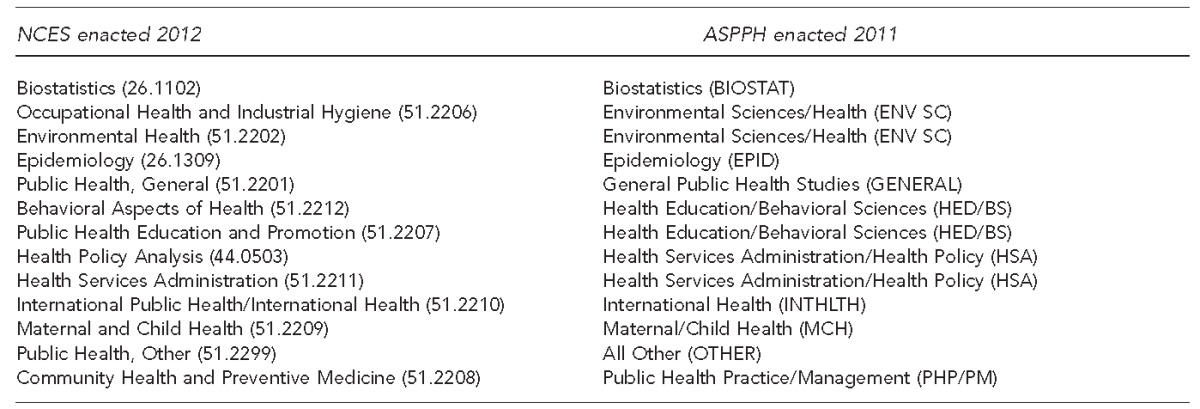
NCES = National Center for Education Statistics
CIP = Classification of Instructional Program
ASPPH = Association of Schools and Programs of Public Health
Table 2.
Definition of ASPPH program areas used to categorize type of public health degrees awarded at U.S. institutionsa
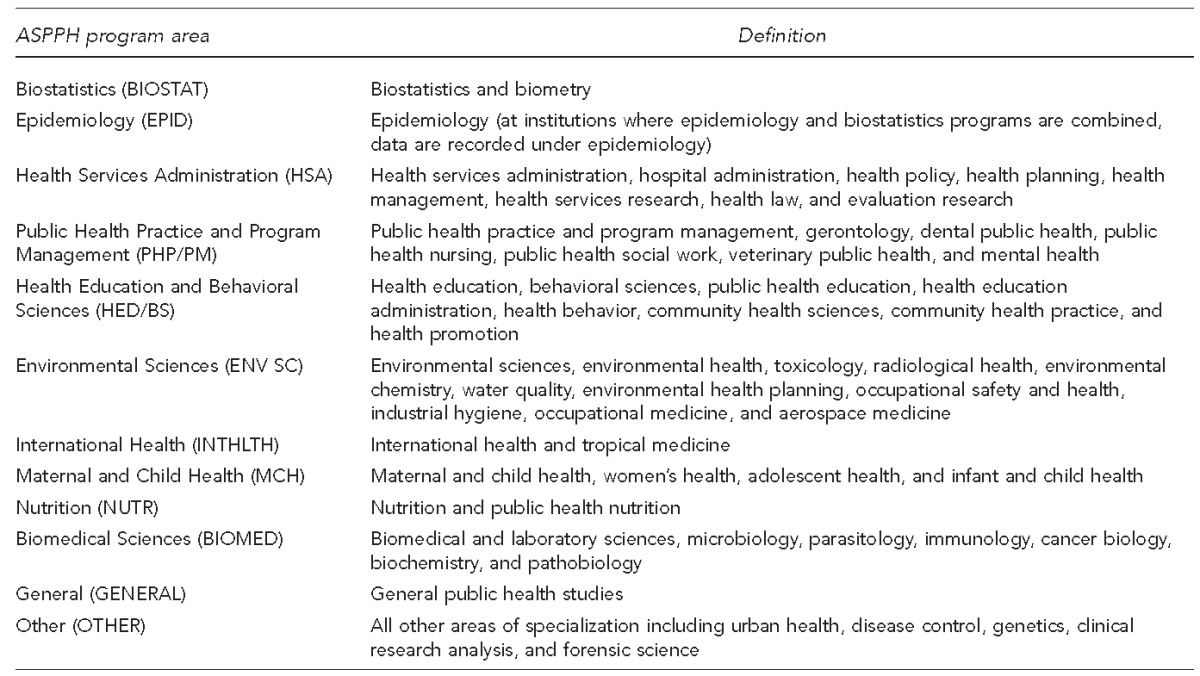
The classification system for program areas was developed by the ASPPH Data Advisory Committee in 1978 and has been used since the 1979–1980 academic year. The system undergoes periodic review and revision by the committee.
ASPPH = Association of Schools and Programs of Public Health
We examined the distribution of public health undergraduate conferrals by race/ethnicity and gender. Race/ethnicity data were limited to 2003–2012 due to a lack of consistent data in this category prior to 2003. A new standard for reporting race/ethnicity implemented in 2009 and 2010 based on guidance from the Office of Management and Budget also impacted these data. We checked that the race/ethnicity data were consistent before and after the new standards were in place. Measures appeared largely comparable during this time period; however, interstandard compatibility may have been an issue.17 NCES data do not include the race/ethnicity of graduates who are nonresident aliens.
We found significant variability across years in the reported conferrals from many smaller public health programs (<10 degrees conferred per year) during our initial analyses. This variability was both in total number of awards and the presence or absence of any degree conferrals. The variability in the presence or absence of degree awards led us to hypothesize that there may be inaccuracies in the reporting of conferral numbers from some of these smaller programs, especially when this fluctuation occurred at seemingly small programs at otherwise large institutions. We ran sensitivity analyses that excluded institutions with <10 degree conferrals in public health reported per year to explore this hypothesis.
We used Stata® version 11.0 for data management and analysis,18 and we visualized data using Stata version 11.0, Microsoft® Excel, and ArcGIS® version 10.1.19
RESULTS
Overall undergraduate trends in public health
Nearly 50,000 undergraduate students graduated with public health majors from 1992 to 2012, and half of these graduations occurred after 2008. The number of public health conferrals increased from 759 in 1992 to 1,469 in 2004 (Figure 1). The number of public health conferrals increased to 6,464 by 2012. Public Health Education/Behavioral Sciences (27% in 2012) and Public Health, General (25% in 2012) were the most common program areas from 1992 through 2012 (Table 3).
Figure 1.
Number of undergraduate public health conferrals in the U.S., by ASPPH program area, 1992–2012
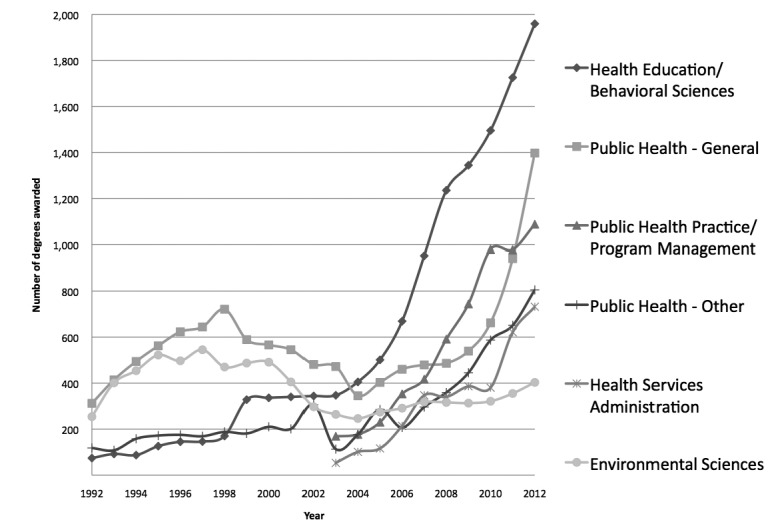
ASPPH = Association of Schools and Programs of Public Health
Table 3.
Undergraduate public health conferrals in the U.S., by ASPPH and NCES program areas: 1992–2012 selected years
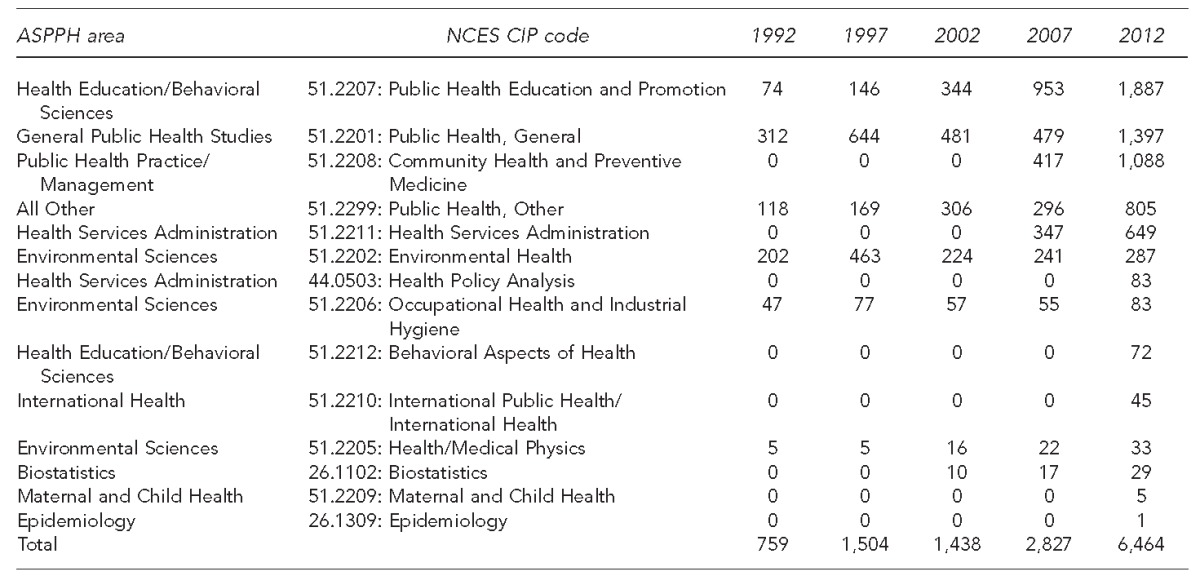
ASPPH = Association of Schools and Programs of Public Health
NCES = National Center for Education Statistics
CIP = Classification of Instructional Program
CEPH accreditation
In 2012, of the 6,464 undergraduate conferrals in public health, a total of 1,607 (25%) came from institutions with CEPH-accredited baccalaureate programs associated with a CEPH-accredited graduate school or program of public health. A total of 1,187 conferrals (18%) came from institutions that had only graduate-level accreditation by CEPH (but no undergraduate-level CEPH accreditation), and 3,670 (57%) came from the 127 institutions that were not accredited by CEPH either at the undergraduate or graduate level (Table 4). However, of these 127 institutions, 44 graduated fewer than 10 students in 2012, and 39 institutions graduated 10–24 students (data not shown). CEPH issued guidance for accrediting standalone baccalaureate programs in public health in 2013, which may impact this distribution in the future.14
Table 4.
Number of U.S. institutions conferring undergraduate public health degrees and number of conferrals, by accreditation status, 2012

CEPH = Council on Education for Public Health
Demographic trends
Women and minority students had greater representation in public health conferrals compared with the total number of undergraduate conferrals in the U.S. From 1992 to 2012, the proportion of women earning undergraduate public health degrees increased from 61% (461 of 759) to 78% (5,074 of 6,464), a 29% increase vs. a 6% increase in the proportion of women earning undergraduate degrees overall in the U.S. compared with men (data not shown). Undergraduates receiving degrees in public health were also more diverse than undergraduates overall (Figure 2), with increases in both Asian and Pacific Islander graduates (from 5% in 2003 to 12% in 2012) and Hispanic graduates (from 6% in 2003 to 9% in 2012). Non-Hispanic white undergraduates received proportionately fewer degrees overall, decreasing from 62% in 2003 to 53% in 2012. The proportion of total non-Hispanic black undergraduate conferrals also declined from 23% in 2003 to 18% in 2012.
Figure 2.
Proportion of undergraduate public health degrees awarded at U.S. institutions in public health (left) and all fields (right), by recipient's race/ethnicity,a 2003–2012
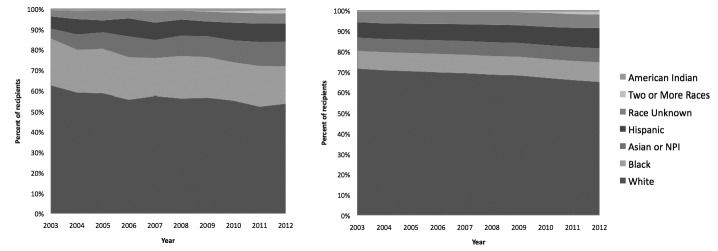
aAll race/ethnicity categories are repeated here as mutually exclusive. Students who reported Hispanic (any race) are reported as “Hispanic,” or under “Two or more races,” as appropriate.
NPI = Native Pacific Islander
Institution and program size
In 1992, 45 institutions awarded undergraduate public health degrees, with an average of 17 degrees per institution (median 5 15, maximum 5 63). By 2012, 176 institutions awarded undergraduate public health degrees, with an average of 37 degree conferrals per institution (median 5 19, maximum 5 341) (Table 5). In 2012, the 16 institutions graduating the most students (9% of all institutions) conferred 2,294 undergraduate degrees in public health, representing 35% of all such degrees. Public health programs graduating fewer than 10 students per year accounted for 32% of all institutions that award public health degrees but only 4% of total conferrals in the field. The median number of public health conferrals changed nominally despite the marked increase in the number of conferrals (data not shown). This finding indicates a concentration of graduates in larger undergraduate public health programs.
Table 5.
Total number of U.S. institutions awarding public health degrees and total number of public health degrees awarded, by size of program, 2012

aNumber of public health degrees awarded at institution in 2012
Other institutional characteristics
Of the 6,464 public health students graduating in 2012, a total of 5,172 (80%) attended universities offering up to a doctoral degree in any field or discipline, a total of 930 (14%) attended colleges and universities offering up to a master's degree, and 362 (6%) attended colleges and universities offering up to a bachelor degree. A total of 2,641 students (41%) graduated from primarily large (.10,000 full-time undergraduate student enrollment), highly residential four-year institutions; 1,823 (28%) graduated from large, primarily nonresidential institutions; and 1,096 (17%) graduated from medium-sized institutions (5,000–9,999 enrolled full-time students) (data not shown).15,16
In 2012, of the 6,464 students receiving undergraduate degrees in public health, a total of 4,706 (73%) attended a college or university located in a city. A total of 410 (7%) students graduated from an institution located within a suburb, 880 (14%) students graduated from institutions in towns, and 468 (7%) students graduated from colleges and universities in a rural area. A total of 4,863 (75%) students graduated from public institutions, 1,182 (18%) graduated from private not-for-profit institutions, and 419 (6%) graduated from private for-profit institutions. The number of graduates from private for-profit institutions increased from <2% in 2005 to 6% in 2012 (data not shown).
Geographically, 11 California colleges and universities conferred 751 undergraduate degrees in public health (12% of total), followed by institutions in North Carolina (12 institutions, 523 degrees [8% of total]), Florida (six institutions, 513 degrees [8% of total]), Oregon (four institutions, 416 degrees [6% of total]), and New York (eight institutions, 361 degrees [6% of total]) (Figure 3).
Figure 3.
Map of institutions conferring undergraduate degrees in public health in the U.S., 2012
Characterizing institutional growth
In 1992, 45 institutions conferred undergraduate degrees in public health, a number that increased to 176 by 2012. In 2012, approximately one-quarter of undergraduates came from institutions awarding their first undergraduate public health degree before 1993 (n545 institutions), and almost one-quarter came from institutions awarding their first public health degree from 1993 to 2002 (n561 institutions) (data not shown). Half of all 2012 undergraduate conferrals in public health came from institutions conferring first degrees within the past 10 years (n5135 institutions) (data not shown), showing significant growth in the number of institutions conferring undergraduate degrees.
Since 2000, an average of 78% of public health students each year have graduated from institutions whose programs had been established for $5 years (median 5 79%, standard deviation 5 5%). We examined this trend (e.g., more graduates coming out of more established programs) by excluding institutions graduating a relatively small number (i.e., <10) of public health students per year. Twenty-eight institutions graduated $10 students in 1992 compared with 120 institutions graduating $10 students in 2012. From 1993 to 2012, an average of six additional institutions began awarding $10 degrees each year, on average (median 5 5) (Figure 4).
Figure 4.
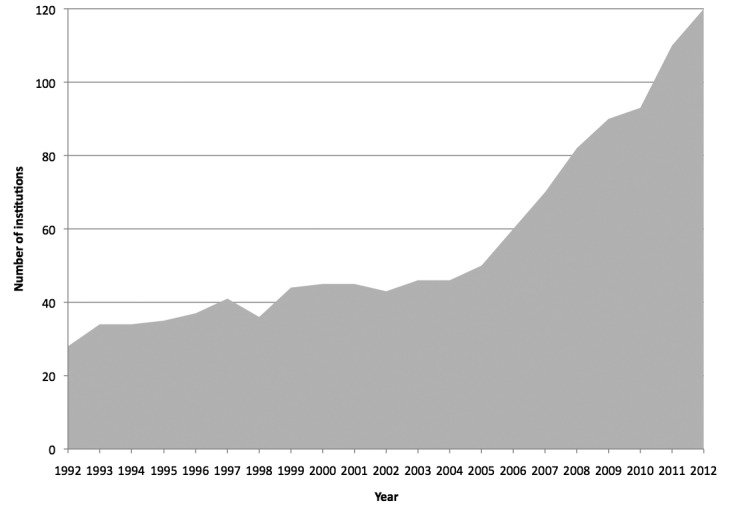
Total number of institutions with ≥10 public health undergraduate conferrals per year: U.S., 1992–2012
Comparison with growth in other undergraduate programs
From 1992 to 2012, among midsize and larger CIP categories (i.e., with $1,000 conferrals nationally in 2012 and $1 degree conferral in 1992, n5151), Public Health (CIP code 51.22) ranked as the ninth fastest-growing category (data not shown). Undergraduate degree conferrals in Public Health grew 750% from 1992 to 2012 (12% average growth each year). From 2008 to 2012, among midsize and larger CIP categories (i.e., with $1,000 conferrals nationally in 2012 and $1 degree conferral in 2008, n5157), Public Health ranked as the 10th fastest-growing category (Table 6). In those five years, the number of undergraduate conferrals increased by 90% (18% average growth each year) (data not shown).
Table 6.
Fastest-growing midsize undergraduate programs in the U.S., 2008 and 2012

aThis CIP code is a form of engineering; Environmental Health is designated under 51.2202.
bThis total does not reflect additions from Epidemiology, Biostatistics, or Health Policy Analysis, which the National Center for Education Statistics classifies outside of 51.22: Public Health.
CIP = Classification of Instructional Program
DISCUSSION
Formal training in public health has historically been delivered primarily through graduate education.9,20 Our analysis shows this graduate-level focus to be changing. Since 2005, a significant, sustained, and increasing number of students have been receiving undergraduate degrees across all types of public health programs, particularly in General Public Health, Public Health Education and Promotion, and Community Health and Preventive Medicine. The data documenting this trend confirm anecdotal evidence that public health has been gaining interest as an undergraduate major.5
Will demand for undergraduate degrees in public health continue to grow?
Education in public health at the undergraduate level will likely remain constant or continue to grow. Similar fields in the Health Professions and Related Programs CIP code have a larger undergraduate-to-graduate ratio compared with Public Health. The ratio of undergraduate to graduate degrees awarded in Public Health (CIP code 51.22) has shifted in the last five years alone from one undergraduate per three graduate conferrals in 2008 to one undergraduate per two graduate conferrals in 2012. In similar programs, such as Health and Medical Administrative Services (CIP code 51.07), the ratio is the inverse (mean 5 2:1, median 5 1.3:1). This ratio suggests that there may be the potential for public health undergraduates to outnumber public health graduate students. Additionally, many schools and programs of public health have an established capacity for education in public health at the graduate level. Thus, there may be institutional capacity among existing graduate programs to offer an undergraduate program in addition to new, standalone baccalaureate programs entering the marketplace. Continued demand for bachelor-level graduates is needed to sustain this potential growth, which relies, in part, on the quality of education students receive. CEPH's recent decision to offer standalone baccalaureate accreditation is an important decision point in the evolution of undergraduate public health education for this reason. Continued demand may also relate to whether undergraduate public health degrees function as a complementary vs. a substitute degree to further graduate training (especially the Master of Public Health degree).
Post-baccalaureate public health training
There are limited data on the post-baccalaureate activities of students who receive an undergraduate degree in public health. One hypothesis is that these graduates continue into education in the health professions. However, data from medical education and graduate education in public health fail to support this belief. Data from the Association of American Medical Colleges (AAMC) show that relatively few students with public health undergraduate degrees apply to medical school (Table 7) (Unpublished report. AAMC. Special report from the data warehouse: applicant matriculant file, 1992–2012 applicants. 2013). Data from 2007 to 2012 in SOPHAS, the Centralized Application Service for Public Health, show that fewer than 6% (2,313 of 39,163) of U.S. citizens applying to graduate schools in public health through SOPHAS held an undergraduate degree in public health (Unpublished report. Centralized Application Service for Public Health. SOPHAS applicant data. 2013). These data suggest that relatively few public health undergraduates pursue a graduate education in public health. These data run counter to popular beliefs about the career paths of undergraduate students with degrees in public health and beg the question of what these undergraduates are doing once they graduate. To get concrete answers to this question, researchers will need to collect data on the career trajectories of undergraduate public health alumni through surveys and other research -mechanisms. Further research is needed to understand the post-baccalaureate pursuits of these graduates to ensure that the educational product remains competitive.
Table 7.
Number of public health majors applying to medical school at U.S. institutions, by time since undergraduate degree, 1992–2012a
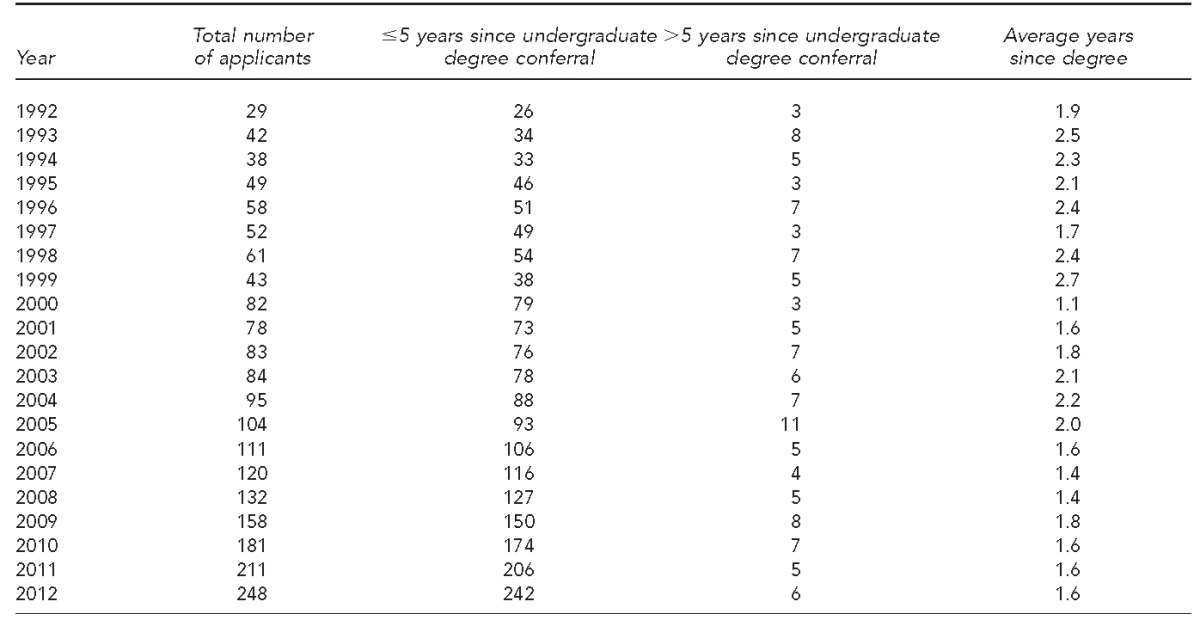
Source: Association of American Medical Colleges. Special report from the data warehouse: applicant matriculant file, 1992–2012 applicants. Washington: AAMC; 2013.
An opportunity for public health
Individuals with undergraduate training in public health are an important potential source of workers for governmental public health, but few opportunities exist to introduce these graduates to this career opportunity. A notable exception is the Centers for Disease Control and Prevention's (CDC's) Public Health Associate Program (PHAP). CDC began this program in 2007 to provide students with an opportunity to participate in a two-year fellowship in state, local, tribal, or territorial health departments. The 2014 cohort included more than 160 fellows with undergraduate training in public health and other fields, all of whom will be qualified for jobs with government public health agencies at the end of their fellowship. PHAP provides a robust model of how public health departments can recruit and train qualified candidates. Similar opportunities may help to encourage more undergraduates to join the governmental public health workforce.21
Limitations
Challenges exist in the classification of instructional programs despite near-universal uptake of reporting degree conferral data to NCES. While NCES provides extensive definitions and clear delineation of programs, the quality of our estimates relies entirely on the quality of the initial data entry by university registrars and data analysts. Misclassification may be more likely among institutions with fewer public health graduates. We ran sensitivity tests excluding institutions with fewer than 10 graduates per year to explore the possible impact of misclassification in the data. Under this sensitivity analysis, the number of institutions changed substantially (approximately one-third decrease) but the number of total graduates changed by only 4%. While the number of institutions actually awarding degrees in public health may be fewer than NCES data suggest, the absolute number of students graduating with undergraduate public health degrees is consistent. A final consideration is how the definition of public health degrees used by NCES is operationalized in institutional reporting processes. Because institutions self-report the number of awarded degrees by type, it may be that institutional differences in the interpretation of what constitutes a public health degree make undergraduate public health programs look different from each other across the country. It is plausible that degrees in related fields (e.g., nutrition science and exercise science) are inappropriately classified as “public health,” although they have their own CIP code in the NCES system. Additional research is needed to examine this possibility.
CONCLUSION
The number of undergraduates receiving degrees in public health has grown from <1,000 in 1992 to >5,000 annually since 2010. This study quantifies a long-held belief that undergraduate conferrals in public health have been increasing. The growth in public health conferrals places increased priority on understanding the post-baccalaureate pursuits of these graduates. Further research is needed to examine where undergraduate public health alumni end up, whether as part of the public health workforce (particularly inside or outside the governmental public health workforce), in other health professions, or in non-health professions. Additionally, further research is needed to establish to what extent undergraduate public health prepares students to enter the public health workforce.
REFERENCES
- 1.Institute of Medicine, Committee on Assuring the Health of the Public in the 21st Century. The future of the public's health in the 21st century. Washington: National Academies Press; 2003. [Google Scholar]
- 2.Association of Schools and Programs of Public Health. Undergraduate public health learning outcomes model. Washington: ASPPH; 2012. [Google Scholar]
- 3.Association of American Colleges and Universities. The educated citizen and public health [cited 2013 Oct 11] Available from: URL: http://www.aacu.org/public_health.
- 4.Wykoff R, Petersen D, Weist EM. Recommended critical component elements of an undergraduate major in public health. Public Health Rep. 2013;128:421–4. doi: 10.1177/003335491312800516. [DOI] [PMC free article] [PubMed] [Google Scholar]
- 5.Riegelman RK. Undergraduate public health education: past, present, and future. Am J Prev Med. 2008;35:258–63. doi: 10.1016/j.amepre.2008.06.008. [DOI] [PubMed] [Google Scholar]
- 6.Cashman SB, Seifer SD. Service-learning: an integral part of undergraduate public health. Am J Prev Med. 2008;35:273–8. doi: 10.1016/j.amepre.2008.06.012. [DOI] [PubMed] [Google Scholar]
- 7.Gebbie KM, Mason Meier B, Bakken S, Carrasquillo O, Formicola A, Aboelala SW, et al. Training for interdisciplinary health research: defining the required competencies. J Allied Health. 2008;37:65–70. [PubMed] [Google Scholar]
- 8.Wright K, Rowitz L, Merkle A, Reid WM, Robinson G, Herzog B, et al. Competency development in public health leadership. Am J Public Health. 2000;90:1202–7. doi: 10.2105/ajph.90.8.1202. [DOI] [PMC free article] [PubMed] [Google Scholar]
- 9.Calhoun JG, Ramiah K, Weist EM, Shortell SM. Development of a core competency model for the master of public health degree. Am J Public Health. 2008;98:1598–607. doi: 10.2105/AJPH.2007.117978. [DOI] [PMC free article] [PubMed] [Google Scholar]
- 10.Honore PA, Costich JF. Public health financial management competencies. J Public Health Manag Pract. 2009;15:311–8. doi: 10.1097/PHH.0b013e31819c1308. [DOI] [PubMed] [Google Scholar]
- 11.Council on Linkages Between Academia and Public Health Practice. Core competencies for public health professionals. 2010. [cited 2014 Sep 5]. Available from: URL: http://www.phf.org/resourcestools/documents/core_public_health_competencies_iii.pdf.
- 12.Hagopian A, Spigner C, Gorstein JL, Mercer MA, Pfeiffer J, Frey S, et al. Developing competencies for a graduate school curriculum in international health. Public Health Rep. 2008;123:408–14. doi: 10.1177/003335490812300325. [DOI] [PMC free article] [PubMed] [Google Scholar]
- 13.Koo D, Birkhead GS, Reingold AL. Competency-based epidemiologic training in public health practice. Public Health Rep. 2008;123(Suppl 1):1–3. doi: 10.1177/00333549081230S101. [DOI] [PMC free article] [PubMed] [Google Scholar]
- 14.Council on Education for Public Health. Accreditation criteria: standalone baccalaureate programs. 2013. [cited 2014 Sep 11]. Available from: URL: http://ceph.org/assets/SBP-Criteria.pdf.
- 15.National Center for Education Statistics (US) IPEDS data center [cited 2013 May 15] Available from: URL: http://nces.ed.gov/ipeds/datacenter.
- 16.Knapp LG, Kelly-Reid JE, Ginder SA. Washington: Department of Education (US), National Center for Education Statistics; 2012. Enrollment in postsecondary institutions, fall 2010; financial statistics, fiscal year 2010; and graduation rates, selected cohorts, 2002–07: first look. NCES 2012–280. Also available from: URL: http://nces.ed.gov/pubs2012/2012280.pdf [cited 2014 Sep 5] [Google Scholar]
- 17.National Center for Education Statistics (US) Changes to race/ethnicity reporting to IPEDS [cited 2013 May 13] Available from: URL: http://nces.ed.gov/ipeds/news_room/ana_Changes_to_10_25_2007_169.asp.
- 18.StataCorp. College Station (TX): StataCorp; 2013. Stata®: Version 11.0. [Google Scholar]
- 19.ESRI. Redlands (CA): ESRI; 2013. ArcGIS®: Version 10.1. [Google Scholar]
- 20.Lee JM, Kleinbaum D, Diener-West M, Grimley DM, Hellerstedt WL, Sullivan L, et al. Teaching excellence in public health: a call to action. Public Health Rep. 2008;123:405–7. doi: 10.1177/003335490812300324. [DOI] [PMC free article] [PubMed] [Google Scholar]
- 21.Centers for Disease Control and Prevention (US) Public Health Associate Program (PHAP) [cited 2014 May 1] Available from: URL: http://www.cdc.gov/phap.



